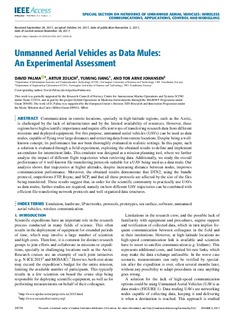| dc.contributor.author | Palma, David | |
| dc.contributor.author | Zolich, Artur Piotr | |
| dc.contributor.author | Jiang, Yuming | |
| dc.contributor.author | Johansen, Tor Arne | |
| dc.date.accessioned | 2017-12-13T11:52:36Z | |
| dc.date.available | 2017-12-13T11:52:36Z | |
| dc.date.created | 2017-11-23T15:01:59Z | |
| dc.date.issued | 2017 | |
| dc.identifier.citation | IEEE Access. 2017, 5 24716-24726. | nb_NO |
| dc.identifier.issn | 2169-3536 | |
| dc.identifier.uri | http://hdl.handle.net/11250/2471117 | |
| dc.description.abstract | Communication in remote locations, specially in high-latitude regions, such as the Arctic, is challenged by the lack of infrastructures and by the limited availability of resources. However, these regions have high scientific importance and require efficient ways of transferring research data from different missions and deployed equipment. For this purpose, unmanned aerial vehicles (UAVs) can be used as data mules, capable of flying over large distances and retrieving data from remote locations. Despite being a well-known concept, its performance has not been thoroughly evaluated in realistic settings. In this paper, such a solution is evaluated through a field-experiment, exploiting the obtained results to define and implement an emulator for intermittent links. This emulator was designed as a mission planning tool, where we further analyze the impact of different flight trajectories when retrieving data. Additionally, we study the overall performance of 4 well-known file-transferring protocols suitable for a UAV being used as a data mule. Our analysis shows that trajectories at higher altitudes, despite increasing distance between nodes, improves communication performance. Moreover, the obtained results demonstrate that DTN2, using the bundle protocol, outperforms FTP, Rsync, and SCP, and that all these protocols are affected by the size of the files being transferred. These results suggest that, in order for the scientific community to practically use UAVs as data mules, further studies are required, namely on how different UAV trajectories can be combined with efficient file-transferring network protocols and well organized data structures. | nb_NO |
| dc.language.iso | eng | nb_NO |
| dc.publisher | Institute of Electrical and Electronics Engineers (IEEE) | nb_NO |
| dc.rights | Navngivelse 4.0 Internasjonal | * |
| dc.rights.uri | http://creativecommons.org/licenses/by/4.0/deed.no | * |
| dc.title | Unmanned Aerial Vehicles as Data Mules: An Experimental Assessment | nb_NO |
| dc.type | Journal article | nb_NO |
| dc.type | Peer reviewed | nb_NO |
| dc.description.version | publishedVersion | nb_NO |
| dc.source.pagenumber | 24716-24726 | nb_NO |
| dc.source.volume | 5 | nb_NO |
| dc.source.journal | IEEE Access | nb_NO |
| dc.identifier.doi | 10.1109/ACCESS.2017.2769658 | |
| dc.identifier.cristin | 1517797 | |
| dc.relation.project | EC/H2020/699924 | nb_NO |
| dc.relation.project | Norges forskningsråd: 223254 | nb_NO |
| dc.relation.project | Norges forskningsråd: 269480 | nb_NO |
| dc.description.localcode | This work is licensed under a Creative Commons Attribution 3.0 License. For more information, see http://creativecommons.org/licenses/by/3.0/ | nb_NO |
| cristin.unitcode | 194,63,30,0 | |
| cristin.unitcode | 194,63,25,0 | |
| cristin.unitname | Institutt for informasjonssikkerhet og kommunikasjonsteknologi | |
| cristin.unitname | Institutt for teknisk kybernetikk | |
| cristin.ispublished | true | |
| cristin.fulltext | postprint | |
| cristin.qualitycode | 1 | |

